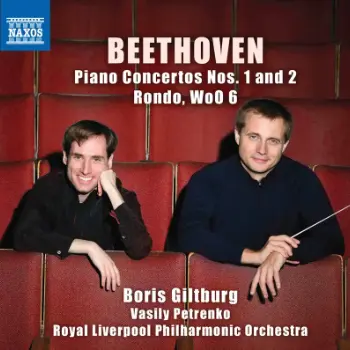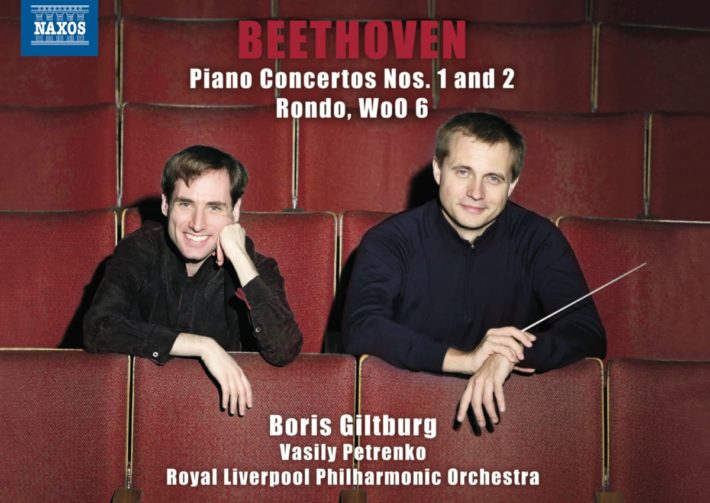We already had our fair share of Beethoven Piano Concertos surveys even before making it to the official year of the 250th birthday celebration (2020). This is the beginning of what Naxos says will be a complete cycle. Both concertos were recorded without an audience at the orchestra’s rehearsal studio (The Friary) over two days last May, with the Rondo WoO 6 joining a few days after.

Although the album starts with the First Concerto, it’s recommended to begin a listening session with the first Concerto to be composed but second to be published, the Concerto in B major, Op. 19. This piece is often treated like an immature attempt by a genius, which in many aspects it certainly is, but nonetheless, it’s a tough work to pull off. With many performances, we get either too small a footprint by the participating forces, or too heavy-handed renditions, trying to make a case for this Concerto as part of the complete cycle of Concertos.
In this case, Giltburg and the Royal Liverpool Philharmonic hit the right note, with a joyful and well-balanced performance. This is evident from the very first bars of the first movement. There is a good sense of direction that leads to the piano entrance and the minor outburst right after is dramatic without being too forceful. Elements in the scoring often emerge with attractive clarity, as in the lovely woodwind dialogue with the oboes at 4’08”. There is also a well-handled restrain at the development section, where a diminished chord is leading to suspenseful melodies by the strings (very reminiscent of a development technique found in Mozart’s Piano Concerto No. 27, K. 595), a moment in which many pianists get too carried away.
The second movement makes a point of hitting the right balance between the lean, transparent sound of historically aware ensembles and emotional warmth – Try the orchestral introduction or the leading up to the cadenza at 7’00”. Andsnes and Vogt’s recent versions went all vibrato-less, while others using bigger string sections leaned to a mid-nineteenth-century atmosphere (Haitink with either Pires or Perahia). Here it’s quite a natural sound, with the strings surrounding the soloist with a sense of sincerity. This is also because of the fine acoustics and recording engineering which, though sometimes places the piano too frowardly in the finales, presents a well-defined sound-image that never feels clinical. Overall, this is one of the more attractive renditions of the Second Piano Concerto we had in years, certainly giving a good case for continuing to record and perform this often overlooked piece.
In Giltburg and Petrenko’s hands, it’s clear that the First Piano Concerto belongs to the sound-world of the Third Concerto rather than the second. Timpani and trumpets are punchy but not rustic as in Andsnes’ version, again forgoing an attempt to imitate the early nineteenth-century brass sound. It’s effective nonetheless. Perhaps not as edgy as other versions, but flowing and cohesive. And it includes some remarkable pianism; Listen to the sudden changes in dynamics at 5’15 (track 1), or the fast trill in the right hand with staccato in the left in the second movement (track 2, 7’00”).
In the first movement of the C Major Concerto, Giltburg chooses the shortest of the available Cadenzas (there are two complete and one in a more sketchy form). This may disappoint those who cherish the deliberate games of expectations and humor of the long cadenza, but others will realize how much attention the longer cadenza attracts to itself (and the pianist), making the movement practically come to a halt. In the slow movement, Giltburg and orchestra are making the best out of Beethoven’s lyricism. The pianist cherishes the waltz-like return of the main subject (5’58”) and the delicate, heartwarming dialogue with the clarinet from 8’00 to the end of this movement is simply lovely.
The first Concerto finale is another example of measured humor and good taste. The minor episode, sometimes given too much weight, strikes just the right amount of drama, without losing the overall lightness of the movement. Overall, a fine account of the First Concerto.
Looking back at relatively recent cycles, Andsnes is impressive but his way with the orchestral accompaniment may bother some for its leanness and over-transparent delivery. Yafim Bronfman under David Zinman is a fine cycle, but in the first two concertos the piano covers up the orchestral layers almost completely. Going even further back, Andris Schiff with the Staatskapelle Dresden under Bernard Haitink is still among the best Digital versions (especially impressive in the finales) and Alfred Brendel is a dedicated proponent of the big Beethoven sound, superbly accompanied by the Vienna Philharmonic under Simon Rattle. This new version is a terrific start to a new cycle. Hopefully, this high level of execution will remain for the next volumes, to be released next year.

Album Details |
|
|---|---|
| Album name | Beethoven – Piano Concertos 1 & 2 |
| Label | Naxos |
| Catalogue No. | 8574151 |
| Artists | Buris Giltburg, Royal Liverpool Philharmonic Orchestra, Vasily Petrenko |
Included with an Apple Music subscription:
Available on Presto Music
Latest Classical Music Posts



















